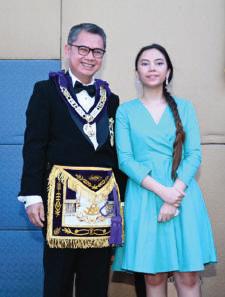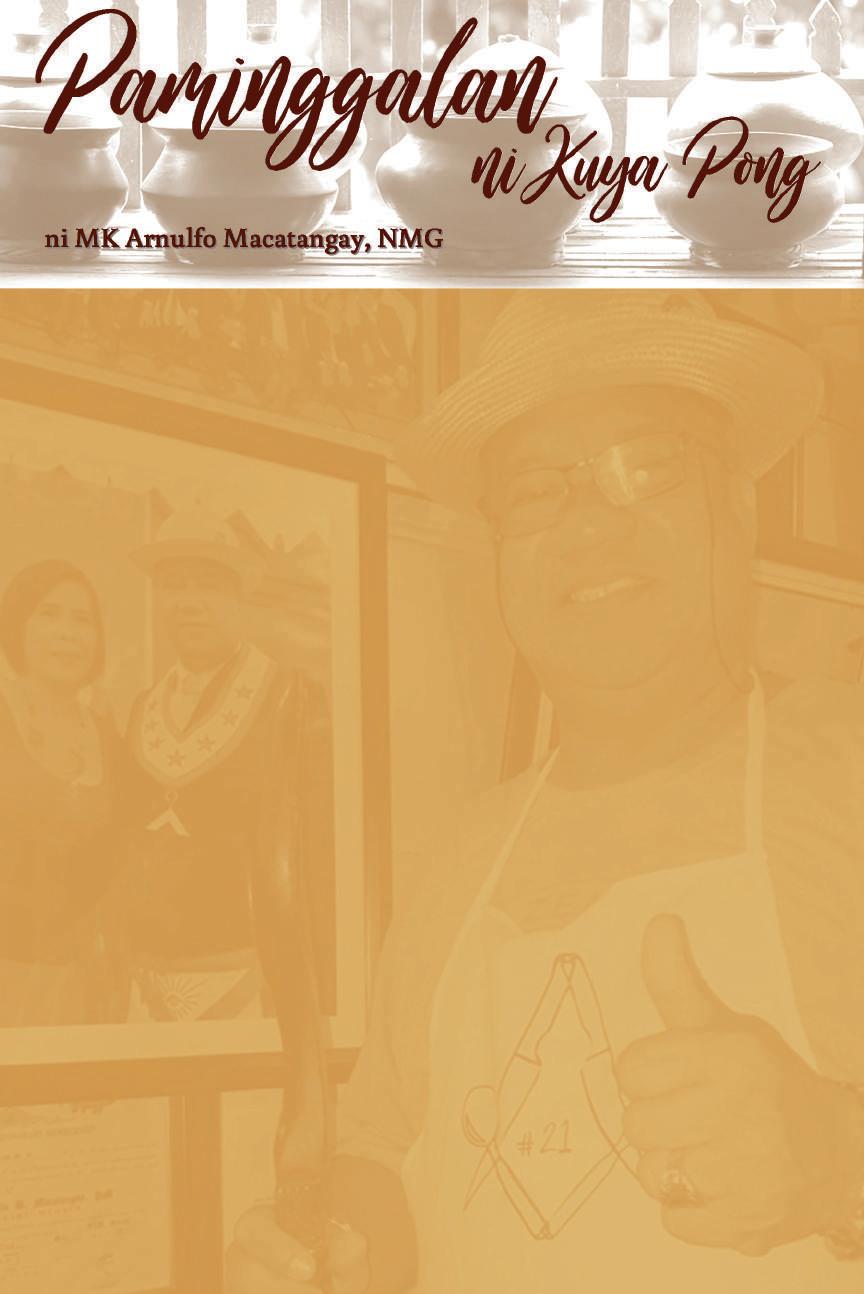
6 minute read
Trivium, Quadrium, & the Summit of the Winding Stairs
LEGENDS OF THE CRAFT
TRIVIUM, QUADRIVIUM, AND THE SUMMIT OF THE WINDING STAIRCASE By Bro. Patrick Azanza (12)
Advertisement
Our journey as a mason is no more than a quest for Truth and Knowledge. We are all basically driven by our love for wisdom; the Philio of Sofia from which the term Philosophy has originated. As travelers in search for the Light, it was our desire and thirst for new learning that led us to knock upon the doors of Freemasonry.
As we entered the Temple when we were made an Apprentice, we were like a masonic child being purified in preparation for a much bigger transformation. For outside the Temple are worldly thoughts while inside are the most ideal, sacred, and divine. As we moved to acquire the next higher degree of the Fellow Craft, having cleansed our hearts, and prepared our minds for illumination, like the vibrant youth that it symbolizes, we first enjoyed a masonic taste of intellectual excitement. Moving into the Sanctuary, our childhood ends and our glorious trek to manhood begins. It is at this point when we are greeted by an enchanting symbol which is the winding staircase reminiscent of the one mentioned in the Book of Kings (1 Kings 6:8), inviting us to ascend and make the first contemplative step towards Enlightenment, as if fortifying our birth as a true mason by being born into the world of masonic light. We find relief that as compared to a straight ladder which is steep and difficult to climb, the winding staircase is easier to glide and traverse. We are expected to navigate through the steps of the winding stairs, the end of which we cannot see and can only anticipate, the total number of which is 15 which is odd; an important symbolism since the Great Pythagoras considered the odd numbers more perfect than the even counterpart. After entering the porch and passing through the pillars of strength and establishment, as we are done with the years of irrational behavioral as a child, we now commence the stage of our manly life, and face the challenges of selfimprovement until we reach the pinnacle where the treasures of Knowledge await us.
We are told that the fifteen steps are grouped into three with 3, 5, and 7 steps, respectively. The first three steps are symbolic of the three officers of the lodge: the Worshipful Master, Senior Warden and Junior Warden, who are all expected to assist every aspiring mason in his courageous ascent to the summit of Knowledge and Enlightenment. But also the 3 steps represent the Deity, or the powerful triangle, which is the most ancient symbol.
The next five steps represent the five orders of architecture which comprise the classical set of rules or principles for designing buildings that give the aspirant mason ideas and choices as to how to build his spiritual and intellectual temple. The first three, the beautiful and desirable symbols from the Greeks, are the Doric, Ionic and Corinthian. Added by the legacy of the Romans with their design of plain Tuscan and the ornamental Composite. These five steps also represent the five senses of the human nature: hearing, seeing, touching/feeling, smelling, and tasting.
Final to the ascent in the Middle Chamber which we hope will lead us to the summit
of Wisdom and the treasures of Knowledge, are the seven steps which represent the Seven Liberal Arts: the first three are known as Trivium: Grammar, Rhetoric and Logic; and the last four are called Quadrivium: Arithmetic, Geometry, Music and Astronomy. We expect that our understanding of these seven arts and sciences, once fully utilized, shall illuminate our minds, and bring us to the innermost chamber or the most desired Sanctum Sanctorum, the one place where we finally expect to see the Light.
Proverbs 9:1 says, “Wisdom has built her house; she has set up its seven pillars.” In the same manner, these Seven Arts framed by the geniuses of Pythagoras, Plato, and St. Augustine, play very important roles in the growth of a mason’s intellect. A fellow Craft must approach these final steps of the Seven Arts using jewels of attentive ear, instructive tongue, and faithful breast.
Grammar involves words and their meanings. It allows a mason to develop a lexicon that would enable him to effectively communicate with others. Rhetoric is the systematized study of speaking or writing to persuade others. It helps influence other people and convince them to support one’s ideas and take action when necessary. Logic allows every mason to arrive at a conclusion based on inferences and deductions from carefully gathered facts and information. It is very crucial in our search for Truth.
Arithmetic involves numbers and measurements. It allows us to count and figure out the dimensions and quantities that are important in reckoning with our daily activities in life, as well as in building or forming structures through standard mathematical equations. Geometry is the

Source: https://images.app.goo.gl/F5Qn1N7EgXqjcXBc9
foundation of architecture. It deals with the properties of space, distance, shape, size, figures, and positions. It is very important to speculative masons. The basic tools of geometry which operative masons use are the plumb, square, and level. They are used in speculative masonry to teach truthfulness, rectitude of conduct, and the right behavior. Music is the artistic organization of sounds to convey a message. It allows man to enjoy the harmonious tone and melody as well as enables him to set the emotional mood of his environment. Astronomy is the study of the sun, moon, stars, planets comets, galaxies, and celestial bodies. It provides the mason with a perspective of himself in relation to the vast cosmic reality created by a Supreme Being in which he is but a speck or a small dot, so insignificant as compared to the many other forms that exist, yet so important that he should be able to find the reason for his existence.
A true understanding of the Seven Arts should allow freemasons to develop critical thinking. After all, these arts are supposed to allow us to gain enlightenment that the true wages of the speculative mason’s toil and labor are neither corn, wine, oil, nor money but universal knowledge, that leads us to the Truth. There at the summit of the winding staircase is a letter “G”, a symbol of Geometry which is the noblest of all sciences; but most importantly, that “G” also represents God, the greatest source of knowledge and enlightenment.
Thus, as we move further and achieve the degree of the master mason, a stage where hopefully we have gained intellectual maturity, we then realize that the perfection of our being human can only be achieved through time and patience. We learn that Truth is Divine. And that it is symbolized by the Word which can only be obtained through a substitute, one that only our deepest understanding of the will and commandments of the Great Architect of the Universe (GAOTU) can reveal to us. The symbols and allegory, the philosophical learning we had throughout our masonic journey symbolized by the winding staircase, the myth, and the mystic ties - all these have their own value as they are finally pieced together to present a beautiful meaning and understanding of what life is all about. Our quest for Truth leads us to the ultimate summit which is the realization that we can only take possession and gain our true wages when our temporal bodies give way and when our spirit take that final step towards the Celestial Lodge where the GAOTU awaits to grant our greatest reward through Eternity.










